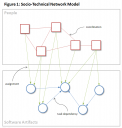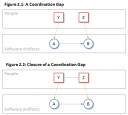The following information was explained by Kate Ehrlich of IBM Research during her talk to the Information Science department on February 22, 2008. Details are copyright IBM.
In engineering projects, communication is essential between people who are working on related tasks. Similar to this idea is the idea of triadic closure, which states that people with a friend in common are more likely to become friends themselves. Software engineering projects provide a unique example to study because the links between engineering tasks (such as program files and pieces of software) are clearly defined and analyzable. These program files (known as software artifacts) inherit, include, require, and otherwise interact with each other, creating a network of relations. Also, the relationships between people can be determined by examining emails and surveying team members.
Kate Ehrlich’s team at IBM used the following model to graph the network of a software development team. The model includes two types of nodes and three types of edges. Artifact nodes are linked to each other by task dependency edges, people nodes are linked to each other by coordination edges, and people nodes are linked to artifact nodes by task assignment edges (see Figure 1).
Figure 1: Socio-Technical Network Model
The resulting “socio-technical network model” can then be analyzed, looking for triadic closure and coordination gaps. When examining the graph, pairs of people who are working on dependent artifacts are identified. If there is a communication edge between the two people, they are said to be working in coordination, otherwise a coordination gap is identified (see Figure 2). Using this method, the entire graph can be analyzed and the extrapolated data can be used to determine where coordination gaps are so that remedial actions can be taken.
Figure 2: Coordination Gaps




* You can follow any responses to this entry through the RSS 2.0 feed.